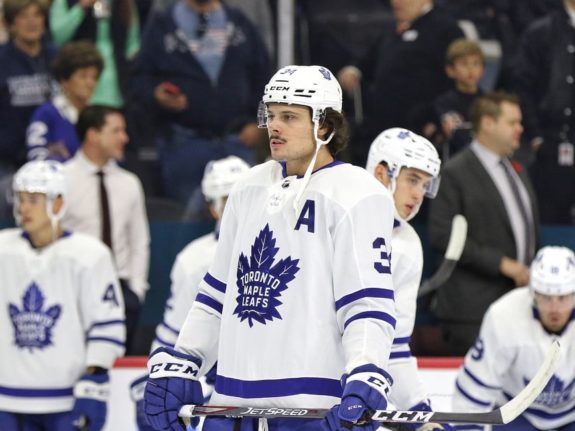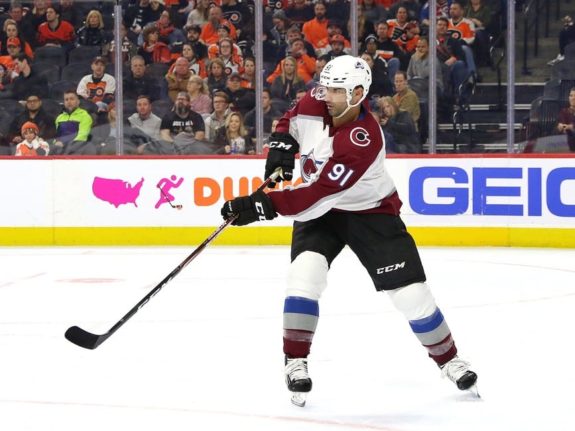
 The Old Prof
The Hockey Writers
The Old Prof
The Hockey Writers
65
Reads
0
Comments
Revisiting the Nazem Kadri Trade
When the Toronto Maple Leafs completed their 2018-19 season, they had failed once again to get past the dreaded Boston Bruins during the first playoff series. When the season concluded, general manager Kyle Dubas had some heavy lifting to do. His defense was weak and, as the general manager, he faced salary-cap problems brought on in part by expensive contracts being paid to no-longer-worth-the-money players like Patrick Marleau and Nikita Zaitsev who had been signed by his predecessor Lou Lamoriello.
Related: Maple Leafs Team News: Tavares, Mikheyev, Toronto Marlies & Kapanen
It’s also fair to say Dubas had contributed to the salary-cap issues by negotiating expensive contracts with William Nylander and Auston Matthews that would cost the team into the future. But those were “his” team-building choices and the attendant problems that arose would be “his” to fix. The jury remains out, but he’ll be on the hook for his team-building choices going forward.

During the 2019 offseason, Dubas moved several Maple Leafs players. Among them were Marleau, Jake Gardiner, and four players who moved to the Ottawa Senators – some by trade and some as free agents – Connor Brown, Ron Hainsey, Zaitsev, and Tyler Ennis.
Why Nazem Kadri Had to Be Traded
One player remained who, eventually, Dubas decided should be moved. That was Nazem Kadri. When Dubas signed now-captain John Tavares as a free agent when his New York Islanders contract expired after the 2017-18 season, the writing was on the wall for Kadri. Matthews was emerging into a superstar center and Tavares would be the other; Kadri’s salary-cap hit – as team-friendly as it was – was simply too was much to pay a third-line center. In addition, his trade value was simply too high to convert him into a winger when cheaper wingers were options.
Related: Who is the NHL’s Top Goaltending Prospect?
At the time, there was also an uprising among some Maple Leafs fans – not all by far – that Kadri was playing out of control and that his playoff suspensions held the team back and could not be tolerated. True, Kadri played with a sense of vigilante justice and couldn’t help but stand up for teammates. That he was regularly penalized by officials for such behavior, and seemingly at the least opportune times, caused many to believe his play had become a problem for the team and it was time to let him go.
As much as I didn’t agree with that sentiment, sadly I also believed trading Kadri was necessary for the team. What I didn’t like about the trade was that, in Kadri, the Maple Leafs had a player who bled blue and white and probably bled it literally and to a fault.
Kadri simply didn’t want to leave Toronto and tried everything he could think of to stay. The Maple Leafs were a team he had grown up with and Toronto, as tough as it was to play in and for as much criticism as he faced, was his town. He said as much to the fans.
On July 1, 2019, Kadri was traded to the Colorado Avalanche with Calle Rosen and a 2020 third-round pick in exchange for Tyson Barrie, Alex Kerfoot, and a 2020 sixth-round pick. Kadri had seen the writing on the wall, and after turning down a trade to the Calgary Flames, he agreed to be moved to the Avalanche.
Kadri’s former teammate and current St. Louis Blues player Tyler Bozak noted that Kadri was an “unbelievable” acquisition for the Avalanche. Bozak believed Kadri was “obviously a guy who is built for the Central Division. He plays hard. He plays tough. And he can put the puck in the net.”
Fast Forward a Year: How’s Nazem Kadri Doing in Colorado
I followed Kadri’s season with the Avalanche, and I hoped it would be a good season (just as I hoped Gardiner would have a good season with the Carolina Hurricanes). I liked both players when they played for the Maple Leafs. Honestly, I can’t imagine I’m alone in retaining loyalty for former favorite players even when they move to opposing teams.

Kadri was having a typical regular-season success for him and would have scored close to 50 points by the end of the season, but sustained a serious lower-body injury in early February in a game against the Minnesota Wild. That injury might have caused him to miss the remainder of the 2019-20 season, but COVID-19 intervened. On the date of his injury, he had scored 19 goals and 36 points in 51 games.
During Round 1 of the playoffs, the Avalanche disposed of the Arizona Coyotes quite handily. In Game 1, Kadri scored the game-winning goal in his team’s 3-0 victory. The Avalanche, a team that has a good chance to go far this postseason, dominated the Coyotes. However, goalie Darcy Kuemper held the Avalanche scoreless for 53 minutes. Finally, Kadri scored a power-play goal, and the Avalanche erupted for two more goals during the next two minutes. That goal was Kadri’s second goal of five points during four postseason games.
Related: Maple Leafs’ Forgotten Ones: Glen Wesley
Kadri then scored two goals and added an assist in his team’s 7-1 win over the Coyotes in Game 4. Both goals came on first-period power plays and were scored less than four minutes apart. By adding a second-period assist, Kadri now had four goals and nine points in seven postseason games.
The Avalanche then finished off the Coyotes with another 7-1 victory in Game 5. Again Kadri scored two goals. His first goal came on another power play, and he’s been getting first-team power-play minutes partnering with Gabriel Landeskog and Nathan MacKinnon. Kadri’s second goal came late during the first period when he broke in alone on Kuemper.
In total, Maple Leafs fans rooting for the 29-year-old London, Ontario-native should be pleased. Kadri has had a great first postseason with his new Avalanche teammates. He’s playing regularly in the team’s top six as the second-line center and during his first-round playoff series scored 6 goals and 11 points in 8 games.
Wishing Kadri Luck During the Remainder of the Postseason
I get it that sports is a professional enterprise and that players are movable commodities. That’s a cost Kadri paid for earning a salary in the millions each season. But I also appreciate loyalty and love when players have a chance to finish their careers – if they choose – with teams they really want to play with.
As a result, when Dubas traded Kadri last offseason, I was of two minds. First, I wasn’t fazed that Kadri’s postseason suspensions had drummed up an outcry from Maple Leafs fans that he had to go; however, I knew teams had to be built and that Kadri was a valuable trade chip. It was time to trade him.
Related: What Happens if the Maple Leafs’ Nick Robertson Is Really Good?
However, I also loved that he tried hard to stay and turned down a Flames trade because he saw a chance to play with his beloved Maple Leafs. I hope he does well with the Avalanche. In addition, watching Dubas over the past season and knowing that players stay in touch even if they no longer play together, I believe many of those still employed with the Maple Leafs feel the same way.
The post Revisiting the Nazem Kadri Trade appeared first on The Hockey Writers.
Popular Articles

















































 Blackhawks Chicago
Blackhawks Chicago Panthers Florida
Panthers Florida Penguins Pittsburgh
Penguins Pittsburgh Rangers New York
Rangers New York Avalanche Colorado
Avalanche Colorado Kings Los Angeles
Kings Los Angeles Maple Leafs Toronto
Maple Leafs Toronto Bruins Boston
Bruins Boston Capitals Washington
Capitals Washington Flames Calgary
Flames Calgary Oilers Edmonton
Oilers Edmonton Golden Knights Vegas
Golden Knights Vegas Islanders New York
Islanders New York Sabres Buffalo
Sabres Buffalo Red Wings Detroit
Red Wings Detroit Senators Ottawa
Senators Ottawa Lightning Tampa Bay
Lightning Tampa Bay Flyers Philadelphia
Flyers Philadelphia Devils New Jersey
Devils New Jersey Hurricanes Carolina
Hurricanes Carolina Blue Jackets Columbus
Blue Jackets Columbus Predators Nashville
Predators Nashville Wild Minnesota
Wild Minnesota Blues St. Louis
Blues St. Louis Stars Dallas
Stars Dallas Jets Winnipeg
Jets Winnipeg Mammoth Utah
Mammoth Utah Sharks San Jose
Sharks San Jose Canucks Vancouver
Canucks Vancouver Ducks Anaheim
Ducks Anaheim






